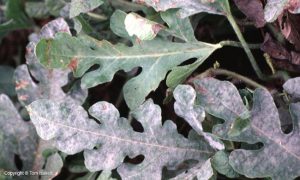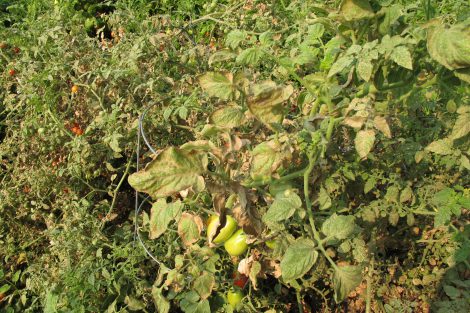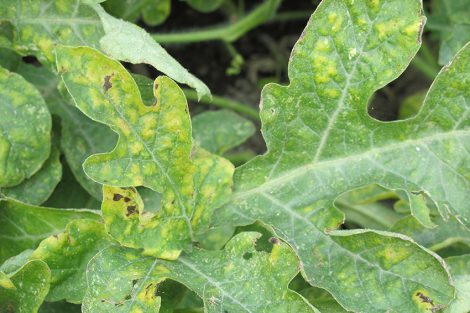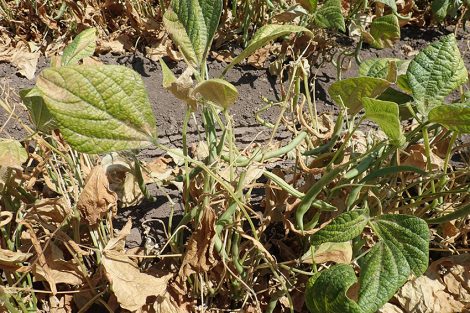In this Issue:
- Powdery Mildew: Found on melons throughout the state
- Two-Spotted Spider Mites: Damage seen on various vegetable crops
- Earwigs: Causing damage to sweet corn in the Salt Lake County area
Powdery Mildew on Melons

In northern Utah, we are seeing a high incidence of powdery mildew on melons (and other members of the Cucurbitceae family). The fungi that cause powdery mildew thrive in Utah’s hot, dry conditions because they do not “like” free-standing water from rain or overhead irrigation.
Description: Powdery mildew is a fungal disease. In cucurbits it is specifically caused by the fungi Podosphaera xanthii and Erysihpe chicoracearum. The sign of this disease is patches of “white powder” that cover the surface of the leaves. This “white powder” that we see is a mix of spores and mycelium of the fungus.
Damage to Host: The infection will cover parts of the leaves, which reduces photosynthesis and thus overall plant vigor. Leaves turn chlorotic (yellow) and wilt, and fruits become scalded due to sudden exposure to sunlight.
Monitoring: Powdery mildew overwinters in the fruiting structures of plant debris. When the temperature heats up in late spring, the fungi will release secondary spores (conidia) that cause the new infections. This spore cycle production will occur all season long, therefore requiring consistent monitoring.
Application of a fungicide should occur every 7-10 days (up to 3 times per season) upon sighting the powdery mildew. Regularly inspect the undersides of leaves to identify the start of powdery mildew infections. If powdery mildew has completely covered the leaf surface, applications will no longer be effective.
Cultural Control Practices:
- Powdery mildew can overwinter in the fruit structures of the plant residue. Therefore, removing plant debris at the end of a season could break the disease cycle.
- Plant resistant varieties of melons. These could include “Hannah’s Choice”, “Athena”, “Strike”, and “Wrangler” for cantaloupes.
- Increase the spacing when planting, in order to prevent infection.
Treatment Options:
Additional Information:
- Melon Production in Utah (Cantaloupe and Watermelon)
- Powdery Mildew
Two-Spotted Spider Mites on various Vegetable Crops
We are noting very high numbers of two-spotted spider mites in our northern Utah monitoring sites, especially on melons, cucumbers, beans, and tomatoes.
Description: Newly hatched spider mites are round and lack spots. As they mature into adults, they turn oval, yellow to olive color, and develop two black spots on their abdomen. Spider mite eggs are translucent, less than a millimeter in size, and typically found on the underside of leaves.
Damage to Hosts: Symptoms include stippling on the plant foliage, followed by scorched (brown) leaves. The mites also produce a silk webbing on the underside of the leaves which leads to discoloration and leaf deformation.
Monitoring: In the summer, females can lay up to a 150 eggs in a 6-week period. A single generation can be completed in 2 weeks during the hot temperatures. Therefore, it is important to monitor starting mid-spring. Check the undersides of the leaves closest to the ground first. The mites are barely visible to the naked eye, and require a hand lens (10X) to see.
Cultural Control Practices:
- Use a strong spray of water to “wash” the mites off the foliage of the plants. (Be sure to spray both sides of the leaves).
- When fertilizer, use a slow-release nitrogen fertilizer as high levels of N encourage spider mite production.
- Minimize dust in the area, as dust would protect pest mites from predatory mites.
Treatment Options:
- Home Pesticide Options (Cucurbits/Squash, Melons, Onions, and Sweet Corn)
- Commercial Pesticide Options (Cucurbits/Squash, Melons, Onions, and Sweet Corn)
Additional Information:
Earwigs on Sweet Corn

Earwigs are a pest of many vegetable crops, and we recently found infestations affecting sweet corn in Salt Lake County.
Description: Earwig adults have a brown body with a red/maroon head. They’re identified easily by the pinchers found at the rear of the body. These are used as defense, mating, and catching prey. The curvature of the pinchers can be used to determine the sex of the insect. Populations are more likely to be found in highly irrigated and mulched areas. Young earwigs are called nymphs, and start off white in color and develop through four instars.
Damage to Host: On corn, earwigs can be found feeding on the silks and occasionally kernels. This is a problem, as it prevents the corn’s pollination, causing a deformed cob.
Monitoring: Adults overwinter in the soil. The females lay their eggs in the spring in groups of 30-50 eggs within the soil. Two generations occur each season in Utah, with highest densities occurring in mid to late summer. Therefore, start looking for earwigs on vegetable crops in late spring.
Cultural Control Practices:
Traps are an effective method for both capturing and monitoring an earwig population within your sweet corn. Some homemade options include baited containers with punched lids at the base of the plant. Bait could include fish oil, bacon grease, or wheat bran.
Treatment Options:
Additional Information:



